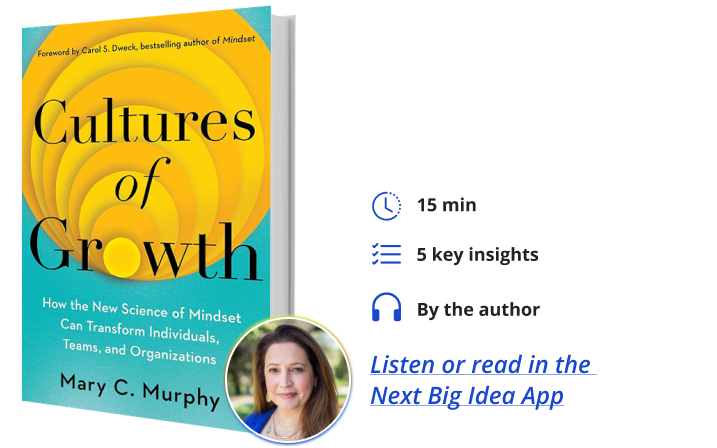Mary Murphy is a social psychologist, researcher, and professor at Indiana University and Stanford University. For more than a decade, she has been working with families, schools, and companies to identify how to build environments where we’re supported to grow and flourish.
Below, Mary shares five key insights from her new book, Cultures of Growth: How the New Science of Mindset Can Transform Individuals, Teams, and Organizations. Listen to the audio version—read by Mary herself—in the Next Big Idea App.

1. We all have both a fixed mindset and a growth mindset.
You’ve probably heard of the concept of the growth mindset, first developed by my PhD mentor, Dr. Carol Dweck. The growth mindset is a belief in continuous learning. That if we apply ourselves, seek help when we’re stuck, and pursue good strategies, our ability to grow is essentially unlimited. Conversely, the fixed mindset is a belief that we’re born with a relatively static set of innate skills and abilities—we either have it or we don’t. Over the last several decades, “mindset” talk has become ubiquitous. The problem is that we’ve been thinking about mindset wrong.
If you do a Google images search of “fixed and growth mindset” you’ll see two heads and a question: Which mindset do you have—fixed or growth? I’ve seen such posters on the walls of classrooms where the teachers say they teach growth mindset. Pretty ironic, don’t you think?
The problem is that mindset isn’t a dichotomy, and it isn’t static. We don’t have a fixed or a growth mindset. We all have both. Mindset exists on a continuum. Sometimes we operate more from our fixed mindset, while other times we operate from our growth mindset. The question these posters should ask is how and when do we move along the mindset continuum?
2. Identify mindset triggers to create a growth mindset culture.
Mindset triggers are the routine, common situations that cause us to move between our fixed and growth mindset. Our research has identified four triggers that predictably shift a person along the mindset continuum. Almost everyone identifies with at least one or two—and if you’re like me, you can see yourself in all four!
The first mindset trigger is evaluative situations. Evaluative situations happen when we’re taking part in an activity—like giving a presentation or pitching a new client—where we know we’ll be evaluated by others. In these situations, we can focus on proving and performing because what matters most is how we come across to others and how smart people think we are. This is a more fixed-mindset approach. In a culture where some people “have it” and some don’t, we want to prove we’re one of the stars. However, we’re not doomed to always shift into our fixed mindset by evaluative situations. We can turn this trigger into one that moves us towards growth by shifting into learning mode and adopting behaviors oriented towards development and growth.
The second mindset trigger is high-effort situations. High effort situations are those that require more effort, attention, or energy than we’ve had to apply before. In our fixed mindset, we might avoid stretch assignments that require mastering a whole new area or field for fear of falling short. In our growth mindset, we see the opportunity to develop, and we put in place supports to make sure that the effort we’re expending is effective effort moving us toward our goal.
“Mindset exists on a continuum.”
The third mindset trigger is critical feedback. Instead of anticipating an evaluation by others, the verdict is in, and we’re being told not good. Think of a negative performance review. Ouch! If this is our fixed mindset trigger, we hear that feedback as a negative pronouncement on who we are or what we’re capable of. We may even avoid feedback and tune out good strategies our boss is suggesting for us. If it’s our growth mindset trigger, we actively seek out and welcome critical feedback, understanding that it’s essential to learning. Perhaps we cultivate a growth mindset partner who can help us consider the feedback and mine it for learning and strategies.
The fourth and final mindset trigger is the success of others. This is when a peer achieves some level of success or wins the award you thought you’d get. If this is our fixed mindset trigger, we find ourselves demotivated or deflated, or we undercut their achievement. However, we can shift to growth by seeking to identify the strategies they used to try learning what we can authentically implement for ourselves.
3. Mindset isn’t just in your mind.
Twenty-three years ago, I was a Psychology PhD grad student at Stanford University, where I had the opportunity to work with Carol Dweck. One day, I knocked on her office door to ask if we could discuss something. I had just attended a series of seminars where students presented their work to professors and noticed something interesting: The attitudes and behaviors of the professors had a massive impact on the students’ performance—especially in one seminar where students felt pressure to prove that their ideas were worthy. To defend their ideas. Most students choked and then avoided their work because revisiting it was too painful. In another seminar, the focus was on helping students develop their ideas. These professors took a more collaborative approach, asking probing questions and brainstorming ways to improve the work, helping students grow their ideas—and the students left motivated and ready to dive into their work to try new strategies.
As I thought about what was different about these two environments, I saw that these were two different ways to set up a context that people think is motivating—one had the fixed mindset at its center and the other was decidedly growth-minded. When I sat down with Carol, I asked her, “Is it possible that mindset isn’t just in our minds? Meaning, could mindset exist outside of us, in the cultures we create and build? Could it be baked-in to what we say and do and how we interact with each other. And if so, wouldn’t that significantly shape our experiences, motivation, and performance—and how well those groups perform in the long term?”
This kicked off more than a decade of research that has since confirmed that, in fact, some of the biggest influences on our personal mindset are outside of our own heads. Every gathering of two or more people—whether we’re with our kids, partners, friends, schools, coworkers, teams, or our entire organization—each context has its own mindset culture, which influences our beliefs and behaviors. Depending on the nature of the mindset culture, we may be more likely to shift into either our fixed or our growth mindset when those four mindset triggers arise.
4. Genius isn’t all it’s cracked up to be.
There are few things our culture prizes more than a genius, that person who seems to have been born with special skills or talents which make them seem destined to succeed. We believe that these stars can do things the rest of us simply can’t. That they will make the biggest impact, devise the best solutions, and be the most effective leaders. It turns out that this genius mythology is exactly that—a myth. My research shows that many who are labeled early on as geniuses fail to fully develop to their capacity. Similarly, schools that focus on identifying geniuses and companies that focus on acquiring geniuses (what I call Cultures of Genius) tend to underperform. These cultures aren’t good for people or organizations.
“It turns out that this genius mythology is exactly that—a myth.”
The reason for this is that genius mythology is tightly interwoven with the fixed mindset: the belief that talent and ability is essentially static. You either “have it” or you don’t. As a result, kids labeled as gifted, or employees crowned as stars, are put on pedestals—and there’s not much room to grow, learn, develop, or make mistakes. They become terrified of underperforming (of proving the label wrong) and so they play it safe, afraid to stretch themselves for fear of failure. They may also hide their mistakes or, at worst, lie or cheat to maintain their status.
Our narrow prototype of who and what a genius looks like also causes us to overlook people who actually have tremendous capacity to succeed but may be late bloomers or simply do not adhere to the narrow societal prototype of who’s smart. Did you know that billionaire entrepreneur Sarah Blakeley didn’t score high enough on her LSATs to get into law school? But while she didn’t garner the grades to earn her genius status, Blakeley had something better. She had a willingness and ability to engage her growth mindset and to build an environment around her that allowed that growth mindset to flourish. Her consistent focus on learning and continual improvement helped Blakeley disrupt an entire market. Her own willingness to embrace failure in the process of advancement is also something she encourages among her employees. That’s a hallmark of Cultures of Growth, where everyone is supported to learn and develop, and where failure and actively mining mistakes for learning (and then sharing results broadly to benefit everyone) is considered essential to innovation.
5. Everyone is a culture creator.
Throughout the book, I share our latest research findings and stories from people across industries. I show what fixed-minded Cultures of Genius look and sound like, and how people have created and maintained sustainable Cultures of Growth which consistently beat Cultures of Genius—for individuals, teams, schools, and organizations.
I show how companies and organizations like Microsoft, Patagonia, and Shell, as well as hundreds of early-stage startups and entrepreneurs (like the McBride Sisters who run the largest Black-owned wine company in the country), nurture thriving businesses by consistently building a Culture of Growth. Teachers, principals, professors, and school systems throughout the country can create inclusive Cultures of Growth where all students thrive.
Everyone, regardless of role, can be a culture creator. Growth mindset cultures can transform any group, team, or classroom to innovate, collaborate, and reach breakthroughs while also helping each person achieve their potential. Let’s unlock our collective genius by building Cultures of Growth together.
To listen to the audio version read by author Mary Murphy, download the Next Big Idea App today:































